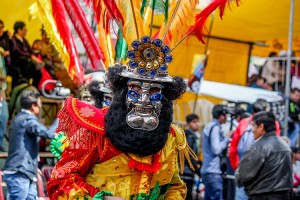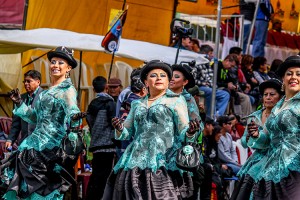Bolivia’s “Gran” Festival
June 14, 2019
This weekend, June 15 and 16, one of Bolivia’s biggest celebrations takes over the streets of the city of La Paz: the Fiesta del Gran Poder (Festival of the Great Power). The dramatic festival celebrates El Señor del Gran Poder—The Man of Great Power, or Jesus Christ—but it also incorporates local culture and traditions of the area’s Aymara indigenous people. Tens of thousands of people take part in the festival’s main parade, which features colorful costumes, boisterous music and dancing, and spectators enjoying local food and drink.

A parade dancer is decked out in vibrant colors and a traditional mask during the Fiesta del Gran Poder in La Paz, Bolivia. Credit: © Niar Krad, Shutterstock
The origins of the Fiesta del Gran Poder stem from an anonymous religious painting donated to the city of La Paz in the 1600′s. The painting includes a representation of Jesus Christ with mestizo features. In this case, a mestizo is a person of mixed Spanish and American Indian descent. The painting gained a reputation for granting blessings and miracles, and it was eventually housed in a La Paz chapel. In the 1930′s, candlelit processions celebrating the painting’s Señor del Gran Poder evolved into a local festival. By the 1950′s, the festival had grown to include bands, dance troupes, and enormous crowds of people.

Costumed dancers take part in the Fiesta del Gran Poder parade in La Paz, Bolivia. Credit: © Niar Krad, Shutterstock
Today, thousands of dancers and musicians representing La Paz’s neighborhoods and folkloric groups parade through the streets. Parade costumes feature vibrant dresses, hats strewn with ribbons, and elaborate masks, all displaying the rich and diverse cultures of Bolivia. The handmade costumes are expensive and can take months to make. Popular dances during the parade include the Diablada (Devil’s Dance), the Morenada (Dance of the Slave), and the Waca Takhoris (Dancing Bulls).
In the days leading up to the festival, prestigious people known as prestes sponsor neighborhood parties, and Roman Catholic Masses, music, and feasts honor El Señor del Gran Poder. At the same time, the Aymara Ch’alla ritual thanks Pachamama (mother earth) for providing bountiful crops and fruits throughout the year. Because the Fiesta del Gran Poder follows a liturgical (religious) calendar, the dates of the festival differ from year to year. In 2020, it will take place June 5 and 6.


